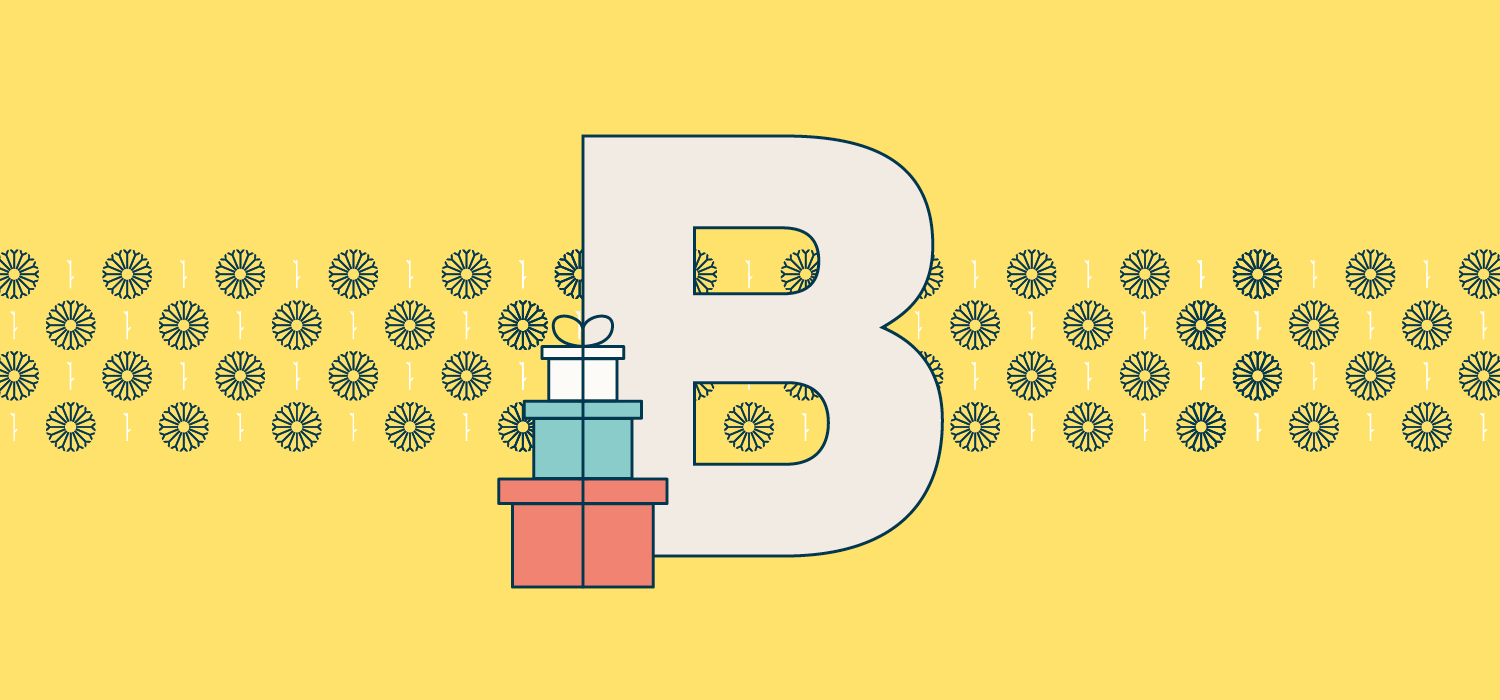Merchandising A-Z
Retail merchandisers love jargon and acronyms almost as much as we love a good set of sales data. We’ve put together our A-Z of merchandising terminology to help you ‘speak’ merchandising. We’ll keep adding to it regularly as new terms emerge (and as we inevitably spot things we forgot to include).
At Flourish, we try to make merchandising accessible to independent businesses, and that means making our information easy to understand. But we don’t avoid jargon altogether. Instead, we want to help you to make sense of these terms wherever you come across them in your working life. Plus, sometimes using an acronym just makes things easier to follow, once you know what it all means.
A is for Attributes
Attributes is the name we give to the way we group products together. For example, we might group dresses using a fabric attribute (e.g. denim, jersey or cotton) dresses, or we might choose to group jeans by shape attribute (e.g. bootleg, flared, straight or skinny). Attributes allow us to look at sales in an aggregated way, meaning we don’t have to plan at too low a level. We’ve got LOTS more on this in our free guide to product hierarchies.
A is also for:
Average Line Buy (ALB): The average quantity you’ve bought of a group of products (e.g. category, sub-category, attribute or whole business). ALB is particularly useful for comparing the current year against the previous one.
Average Order Value (AOV): The amount your customer spends on an ‘average’ order.
Average Selling Price (ASP): This is useful when you’re using attributes or product categories to understand the average price of the group of products. It lets you see if the average selling price has increased or decreased in comparison with last year, so you can understand if you’re selling more or fewer units. ASP also helps you to benchmark individual products and understand their performance. Find out more in our free guide to sales analysis, and put it to practical use with our sales tracker tool.
B is for Buy
Buy is the value of the product which you buy. It’s normally quoted at retail selling value, but it can also refer to cost price.
See also: range plan
B is also for:
Buyers: Buyers choose what stock to buy for a retailer, and then they negotiate and make that purchase. Merchandisers work closely with buyers to help them decide what to buy and in what quantities. We’re often referred to as the ‘Buyer’s Accountant’! Just like merchandising, there’s a UK Government apprenticeship scheme for buyers.
C is for Cover
A cover calculation shows you how many weeks’ worth of stock you’ll have left if you continue selling at the same rate as currently. It helps you spot if something is selling fast and could be potentialised by placing a repeat order for stock, or if it’s moving slowly and needs action to be taken like applying a discount, extra marketing or cancelling stock.
See also: potential cover
C is also for:
Category: The way we group products to allow us to plan and trade. Categories should be logical, e.g. dresses, tops and trousers. Find out more in our free guide to range planning.
See also: product hierarchiesClosing stock: The amount you have at the end of the season. This is used to calculate open-to-buy. You can also take a closing stock value at the end of any given period (e.g. day, month or week) for reporting purposes, as it allows you to work out cover metrics and adjust your plans accordingly.
Commitment: The value of stock which has been ordered from suppliers but is yet to be delivered. If you add together your stock and your commitment, the result tells you the potential cover of a product or a group of products.
Continuity: Lines which are always in stock as they sell a decent volume and are not driven by trends or seasons. A great example would be a simple white t-shirt! Continuity should form the foundations of your range planning. These products should be monitored to make sure they’re always in stock (in all sizes!), but that you aren’t holding too much stock and tying up cash flow. Our sales forecasting tool can help you manage continuity.
Cost Price: The price you pay to a brand or supplier for your product. You can use the cost price to work out profit value and margin percentage.
See also: landed cost price
D is for Data
Merchandisers get very excited about data. It’s the most important resource we have. We’ll work with your data and turn it into something meaningful, so you can take actions that help your business thrive and grow. Read more about how we helped Asquith harness the insights hidden in their data to help the business grow its profits.
D is also for:
Discount: Also called ‘markdown’, this is when you reduce the selling price of a product to help it to sell. It can also be a discount applied as a promotional code at the basket. Our free guide to markdown can help you dig deeper into discounts!
E is for Excel
Excel is the spreadsheet programme we use to crunch all your data and turn it into insights. It’s used by a lot of big retailers, even if they have big fancy systems! If you buy one of our DIY merchandising tools, you’ll find it’s built in Excel. We have two free guides to help you navigate the programme if you’re not already familiar with it – basic and advanced.
F is for Forecast
Merchandisers use forecasts to regularly re-evaluate sales and profits once you’ve started trading. This means you can re-assess what you need to buy, what you need to manage through markdown, etc. It’s always important to re-forecast in season so that you know how your business is doing, however big or small. You can then react by trading.
G is for Growth
Most businesses are aiming for growth, so it’s important to look at which metrics you are growing. You should aim to grow profit, as this will support your business. If you have strong merchandising principles in place it’s possible for sales growth to slow at the same time as profits rise. The number of products in a range won’t necessarily grow, as this can just lead to you splitting sales between more products, so it is important to review the data and consolidate your range. Find out how we helped Sarah Verity Jewellery with exactly this!
See also: range consolidation
H is for History
History is a really important starting point that helps merchandisers build a plan and understand how much product to buy. By using history and applying extra information that’s relevant to the season (e.g. lessons learnt, trends etc.), we can build you a robust plan.
H is also for:
Half: A six-month period which can also be referred to as a season. Plans and finances are usually based on a half, and it’s also the timeframe a business normally trades through.
I is for Intake
Intake is stock which is brought into your business in the time frame which you are looking at. So, if you’re doing a weekly analysis, intake would be the retail value, units, cost and number of options (products) that were brought in that week.
J is for Job
Merchandising is now a university degree and has an apprenticeship scheme in the UK. Most merchandisers start out as a Merchandise Admin Assistant (MAA), moving on to be an Assistant Merchandiser (AM), before becoming a Junior Merchandiser and then a Merchandiser, where you run your own department. After that, you could move on to be a Merchandise Manager or Head of Merchandising, looking after areas of a business (e.g. several womenswear departments). A Merchandising Director will then look after a whole division or business.
K is for Key Performance Indicators (KPIs)
Businesses set KPIs to assess how they’re performing. They’re usually metrics like sales value, profit value or margin, stock targets, and cover. It’s useful to plan these and then measure against them regularly.
L is for Landed Cost Price
Landed cost price is the product price plus the costs of getting that product to you. You can work it out by adding on duty and shipping costs. It gives you a truer reflection of your margin, as it factors everything in.
L is also for:
Lead time: The time it takes for a product to be made and delivered to you so you can add it to stock.
M is for Margin
Margin is the amount of money you make on a product – also known as profit. Margin can be expressed as a percentage, helping you to compare performance between products or categories. The calculation for working out profit margin is:
(selling price / VAT) – landed cost
For example, if your product has a selling price of £25 and a landed cost of £5, and you’re VAT registered, your calculation would be:
(£25/1.2)-£5 = £15.83
You can then work out margin as a percentage, using the calculation:
(profit / (selling price / VAT)) *100
For our example above, that would mean the calculation looks like this:
(15.83 / (£25 / 1.2)) *100 = 76%
M is also for:
Markdown: When you reduce the selling price of a product to help it to sell. It is usually a permanent markdown, so the price will not go back up. Can also be referred to as discount. Check out our free guide to markdown for more…
Markup (MUP): The way we define the difference between your retail price and your wholesale price. You’ll find worked examples of markup in our free guide to wholesale!
Merchandising: What we’re all about at Flourish! Read our introduction to all things merchandising.
Mixes: A mix is the percentage that something (e.g. a category or attribute) has contributed to a total amount. Mixes are a great way to compare different metrics. For example, looking at sales mixes and then at stock mixes can show you if something is overperforming or underperforming. If, say, your sales mix is 10% and your stock mix is 20%, you have more stock than the sales you’re driving. On the other hand, if your sales mix was 25% and your stock mix was just 10%, you’re overperforming and could potentially do with ordering or making more stock to potentialise the sales. You’ll find lots more about mixes in our range plan resource.
N is for Net Sales
Net sales refers to the value or units sold after returns have been taken off. For example, if you sold ten toothbrushes but two were then returned, your net sales would be eight units (or the equivalent value). Net sales help you make sure you don’t buy too much or too little, and that you are aware of and address returns in your business. There’s lots more detail on this in our free guide to reducing return rates.
N is also for:
Numbers: In the hands of a skilled merchandiser, numbers can help to drive your business forward! Numbers might not be your thing, but they’re most definitely ours. We have very big calculators to prove it 😀
O is for Open-to-Buy
Open-to-buy (OTB) is a really important calculation that tells you and your buyers exactly how much cash is available to spend in order to achieve your sales plan. You calculate it by adding together your closing stock value, sales value, markdown spend and stock loss value, and subtracting the value of returns and opening stock.
O is also for:
Opening stock: The amount of stock you have at the start of the season. This is used in the open-to-buy calculation above.
Options: The number of products you have in your range. Options are often grouped together in a category so you can review performance and plan.
P is for Planning
The most important thing you need to do as a small business is to plan your sales so that you know how much money you need to spend, how many options you need to have and what KPIs you will measure for the season. For lots more guidance on planning, check out our free range plan resource.
P is also for:
Product: The items which make up your range.
Product hierarchy: The way your products are grouped and structured. For example, you might structure them by categories and sub-categories (e.g. dresses > short sleeved dresses). This gives you a framework for planning and trading. You’ll find lots more on this in our free guide to product hierarchies!
Potential cover: Potential cover is a calculation that considers the commitment value so that you don’t accidentally order more stock.
See also: coverProfit: The amount of money you make on a product – also known as margin (you’ll find a worked example if you follow that link!).
Promotions: Offers which can be put on products, on your whole website or on your shop to encourage customers to buy. Promotions can include a fixed amount of money off, or a percentage discount which will help you to clear slow-moving products. Promotions could also be more strategic, such as buy one get one half price, spend X to receive Y, charity donations or more. Holly Tucker uses her Colour Friday initiative to encourage small businesses to try out less traditional types of promotions (e.g. charity donations or tree planting).
Q is for Quantity
Quantity refers to the number of products you need to buy or make in order to have enough stock to achieve your sales plan. Find out more in our free guide to range planning.
R is for Rate of Sale
Rate of Sale (ROS) is a way to compare products, and you can do it in a couple of different ways.
You could look at the ROS of a category. This shows you the average number of units sold per option, e.g. if you sell 100 units across 10 options, your ROS is 10 (a simple 100/10). If you compare that to another category which only sold 60 units, but had 4 options, your ROS is 15 (60/4). That means the category that sold fewer units is actually working harder for your business. This helps you identify where you may have too many options which are splitting sales, or where you can add more options.
You can also use ROS to compare stores or weeks, helping you understand how many units to buy. Find out more in our range planning resource.
R is also for:
Range consolidation: The process of optimising the products in a range, using data to make sure you have enough options, and that they’re all equally strong sellers. This can take a bit of trial and error! Find out how we helped Sarah Verity Jewellery consolidate its range.
Range plan: A Range Plan is the ‘retail bible’ as it holds all of the information about your products. It allows you to plan how much to buy of each product, when to start and end the selling period and enables you to roll up things like total spend at retail value and cost and the potential full price profit. Using our range plan tool means you can get analysis to check that your range is balanced.
Returns rate: The percentage of units that are returned, calculated by dividing returns by sales (find out more about returns rates in our free guide). When you’re calculating your returns for your OTB calculation, make sure you only include returns that are available for re-sale. Any returns that can’t be resold should be written off instead, as they don’t go back into stock.
S is for Stock
Stock refers to the total products you own as a business. It’s usually held in a warehouse, a fulfilment centre or a stock room and is either sent direct to the customer or taken out of the store when it is bought. Stock is a constantly moving number and we use stock metrics all the time both in planning and in trading.
See also: opening stock, closing stock
S is also for:
Sales: Essentially, this is what you sell! This could be the total value that goes through your till, or it could be expressed as units or net sales.
Sales plan: The total sales value you’ve planned for your selling period (usually a six-month season). Having a sales plan means you have something to review against as you trade, letting you see if you’re overachieving, hitting or underperforming against the plan.
Season: see half
Sell thru: The percentage of stock you have sold – a great way of comparing products. You work it out by dividing the number of units sold by the number of units you brought into the business, and then multiplying by 100 to make it a percentage. For example, if you brought 100 units into the business and sold 80 by the end of the season, (80/100)*100 = 80%. The higher the percentage the better! You can do this calculation as a total, or you can do it at full price if you prefer.
Stock keeping unit (SKU): A unique code or sequence that identifies your product. An SKU that identifies the product to colour level is a Parent SKU and an SKU that identifies a product down to size level is a Child SKU.
Stock loss: The amount of stock you anticipate losing through the season through loss, damage or theft. Factoring this percentage in means you can buy enough stock to account for the loss and still hit your sales plan. Stock loss is usually only 1-3%, and for online businesses, it might not apply at all.
T is for Terminal
Terminal refers to the amount of stock you anticipate having left at the end of a season. While we’d love to sell everything, there’s usually a little bit left, and this percentage gives us our terminal figure. Terminal is part of your open-to-Buy (OTB) calculation, so retailers often factor it in. It’s often applied as a percentage of the sales plan (e.g. if your sales plan is worth £100k and terminal is 5%, you’ll have £5k terminal). The aim is to keep that number low so you don’t build up terminal that needs to be reduced in price and potentially carried over to the next season (winter coat in June, anyone?). After all, storing stock so you can carry it over to a later season costs money. If you sell out of a product, that’s great, but if you sell out when you could have sold more, then you haven’t fully potentialised your sales. It’s a tough balance!
T is also for:
Tax: The amount of tax which forms part of your selling price. In the UK, this is referred to as VAT, and the tax will be paid to the Government. It’s really important to factor VAT into your pricing so you don’t overstate your profit!
Total: Also known as ‘the bottom line’, this adds up all of your products so you can explore a range of metrics that show the big picture of how your whole business has performed over a given period.
Trading: Trading is the merchandiser’s way of potentialising well-performing areas of stock and de-risking poorer ones. Ideally, we always aim to overachieve on our KPIs (e.g. on our sales plans and profit).
U is for Units
Units is the term we use for the number of ‘things’ you have, taking into account everything that’s been sold or returned, everything you have in stock and on commitment. Units are used to work out a ‘Unit Cover’, which is unaffected by price or markdown.
V is for Value
Value usually refers to a calculation where you multiply your number of units by the unit price. There are various types of value, such as sales value (units x selling price), stock value (stock units x selling price), returns value (returns units x price sold for), and commitment value (commitment units x selling price). There’s also markdown value (the difference between the original selling value and the price sold at) and profit value.
V is also for:
Value Added Tax (VAT): The tax that applies to sales in the UK. Find out more on the gov.uk website.
Volume: The number of units bought and aggregated together. Volume lines are often ones you sell a lot of, and volume can help to reduce cost prices and increase profit as it offers economy of scale to the supplier.
W is for Weekly Sales, Stock and Intake (WSSI)
The Weekly Sales, Stock and Intake (WSSI) tracks all of your different metrics and is an important tool for a merchandiser. A WSSI enables you to ‘see ahead’ (refer to the Sales Forecasting resource) and react accordingly. For example, you can see if you’re hitting your sales plans and forecasts, and you can re-forecast as needed. If you’re doing better than expected, you can order more stock. If you’re doing worse than anticipated, you can see how much excess stock you have and can action markdowns, cancel or reduce commitment as needed. WSSIs can be run at any level, including business, department, category, sub-category or product.
W is also for:
Weeks on sale: The number of weeks you want to sell a product for. For example, you might only want a Christmas jumper on sale for the 6 weeks before Christmas, but you’d want a white t-shirt to be available for all 26 weeks of the season. This can help you see what products will be available to the customer and when, and how many of each item you’ll need to buy (number of weeks x Rate of Sale). You can find out more in our free range plan resource.
Wholesale: The practice of selling your products to another retailer for them to sell. We have a free guide that’s dedicated to wholesale!
X is for XLookup
XLookup is a fancy (and very useful) Excel formula which allows you to look up a value in another spreadsheet. XLookup is only available in Microsoft 365. We love a good formula at Flourish!
Y is for Year
In this context, a year is the trading year for your business. You might run that as a calendar, tax or fiscal year.
Z is for Zest and Zeal
What every business owner needs to help their business flourish and grow! Want us to help you reach those goals?



























